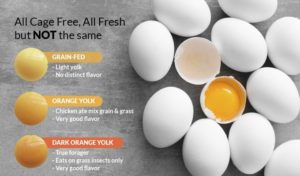Where Paris Failed: Meat!
For months, one of the dominating themes of the 2024 Olympics was sustainability and the Paris Olympic Organizing Committee’s decision to make 60% of all meals served meatless. Organizers pledged to make nearly a third of the 13 million meals they served plant-based.
There’s dumb, and then there’s just plain ole’ stupid. This decision was an example of the latter. They seriously thought someone like U.S. Olympic shot-putter Ryan Crouser would be happy if 60% of his meals were meatless. It didn’t happen.
The athletes complained . . . a lot. They wanted meat and eggs, and plenty of them. To make everyone happy, the Olympic caterers had to bring in an additional 1,500 pounds of eggs and an additional ton of meat.

You can’t trick nature. The Olympics is a gathering of the top athletes in the world, who’ve spent years, even decades, training to be the best. Most of them put a lot of time and effort into learning about and consuming the best diet possible. And for pretty much all of them, this means consuming lots of protein-packed meat, fish, and eggs. It also means consuming real whole dairy products instead of almond and oat milk.
At Exercise Inc, we’ve always recommended eating meat for a multitude of reasons. Humans are omnivores at the top of the food chain. Our large brains are more advanced than any other species on this planet because of the zinc, iron, B12 and fatty acids we get from meat.
Eating meat is important for athletic performance, brain performance, and your overall health. Meat from animals, birds, fish, shellfish and even insects has always represented 45 to 85 percent of the calories in the human diet.
It’s important to eat the right kind of meat, and the right kind is not necessarily boneless, skinless chicken breast. It’s the kind that’s as close as possible to what our ancestors ate. They hunted and ate wild animals that were lean, healthy and happy, living in ways that allowed them to express their “physiological distinctiveness.”
The meat we get at the local supermarket is typically fed corn, or something like it, in concentrated animal feeding operations (CAFOs) and pumped full of antibiotics and steroids. Corn-fed beef is significantly less healthy since it contains more saturated fat and fewer omega-3 fatty acids. But it’s not just conventionally-raised beef that’s less healthy for us; the same thing is true for pigs, chickens, and even fish.
Don’t blame the farmers; they’re just trying to make a living and producing what the food industry is asking for—something they can grow quickly and sell at a huge profit.
In the U.S., about 80% of all antibiotics sold are used in livestock to improve growth rates and prevent infections. Overuse of antibiotics can cause antibiotic resistance, in which bacteria change in some way that reduces or eliminates a drug’s effectiveness against it.
According to the CDC, each year at least 2.8 million Americans are infected with antibiotic-resistant bacteria or fungi, and more than 35,000 people die as a result. The World Health Organization has stated that “antibiotic resistance is rising to dangerously high levels in all parts of the word.” A leading cause of antibiotic resistance is the overuse of antibiotics in livestock production.
When animals live in an environment that allows them to express their natural behaviors and eat the diverse foods they need to be healthy, they don’t need antibiotics. And those animals also have a much higher vitamin profile than animals raised on conventional industrial farms. Cows that are allowed to roam in pastures and eat grass have five times more omega-3 fatty acids than corn-fed cows. This is mostly because cows love to munch on clover, which is loaded with omega-3s. Grass-fed beef is also much higher in vitamins A and E.
Pigs that are allowed to roam freely in a pasture will eat anything they can get their snouts into: roots, grass, leaves, grubs, nuts, berries, fruit and insects. They will also eat just about any table scraps they get. When pigs are raised in an open pasture, they typically have two to three times more omega-3s than conventionally raised pigs. The quality of their fat is just better. And, when you’re eating bacon, quality fat is king.

Chickens that are allowed to roam freely eat a variety of grasses and bugs. It goes without saying that free-range chickens are better for you in every way. Look at the bright orange yolks in their eggs. They’re orange because they have seven times more beta-carotene than conventional eggs. They also have two to three times more vitamin A, three times more vitamin E, and two to three times more omega-3 fatty acids.
So, what’s the best way to find better meat? Michael Pollan, author of In Defense of Food, says you should “Shake the hand that feeds you.” In other words, get to know the person who is raising your food. Go to farmers’ markets and buy food face-to-face from the people who produce it. Ask questions about how they raise their animals. Know what you are eating, and make the investment to buy the highest quality food you can afford—especially meat. If you are going to upgrade the quality of your food, meat is the most important place to start, because the quality of the meat you eat will impact your health more than anything else you eat.
You can find a list of farmers markets in central Indiana at indywithkids.com. Spend some time over the next couple of weeks visiting some markets in your area. Talk to the farmers, sample their food, and buy some of their meat.
Also, check out eatwild.com’s directory of Indiana farms that are producing grass-fed and pastured meat, eggs and dairy products. Several of these farms have delivery locations around the state. Eatwild.com also provides a directory for grocery stores and restaurants that serve quality meat.
The best kind of meat you can eat is grass-fed beef and pastured poultry, pork and lamb that is antibiotic- and steroid-free. You’ll see significant improvements in your health if you spend the extra time and money to acquire this kind of meat, including improved heart function, lower cholesterol levels, reduced levels of bad fats, and an improved immune system.
The 2026 winter Olympics are in Milan and Cortina d’Ampesso, Italy. Let’s hope they learned a lesson from what just happened in Paris. And the 2028 Olympics in Los Angeles shouldn’t have anything to worry about, since the U.S. consumes more meat per person than any country in the world.
Stay Strong,
Bo Railey

